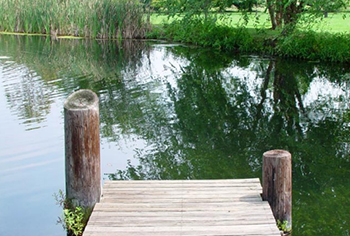 Purdue University - Extension - Forestry and Natural Resources
Purdue University - Extension - Forestry and Natural Resources
Got Nature? Blog

Photo credit: Dan Annarino
Hopefully no one is reading this after a catastrophic loss of their pond. This very wet summer has tested some ponds’ ability to hold and safely release excess water. I would like to quickly review the overflow structures ponds should have and also some management necessary to ensure the safety of ponds levees/dams.
For recreational ponds, there should be one or perhaps two means of releasing water from the pond. Most of these ponds are built on sloping land in order to capture rainwater to fill the pond. In this case, it is necessary to have an emergency spillway that will divert excess water once the pond is full away from the dam to prevent erosion and save the integrity of the structure. Usually they is just an earthen channel that runs around the end of the dam with an initial elevation 1-2 feet below the top of the dam. Water only runs through the spillway when the pond is full. An emergency spillway should have vegetation to prevent erosion but not to the extent that water is blocked from passing through efficiently.
A distinct advantage can be gained by having a drain structure installed through the dam when ponds are initially constructed. Drains such as this typically have a valve or swivel pipe which can regulate water level to whatever height the owner would like. With a wet summer such as we have had, the pond water level could be proactively lowered to save massive amounts of water passing through the spillway.
Additionally you can remove stagnant low oxygen water from the bottom of the pond. If a drain structure is releasing water from the bottom of the pond, it is a good idea to flush this valve two to three times per year to remove debris from around the structure which may plug it up if used infrequently. With these structures, it is a good idea to use the 6/12 rule. Water levels are kept six inches below maximum in order to catch any rain water event without overflowing. Evaporation and seepage will reduce the level back down over time. The 12 refers to the level the inches below maximum where you would add well water if you have the capacity. Generally this is only used with aquaculture ponds.
Control structures to maintain water levels will ensure the integrity of your ponds dams and levees. By controlling the amount of water flushing through a pond, the owner can also manage the productivity of the pond ecosystem by releasing/maintaining nutrients in the pond.
Resources
Commercial Greenhouse and Nursery Production: Controlling Algae in Irrigation Ponds, The Education Store, Purdue Extension Resource Center
Indiana Ponds, The Education Store
Indiana Ponds Q&A, The Education Store
Management of Ponds, Wetlands, and Other Water Reservoirs to Minimize Mosquitoes, The Education Store
Indiana Pond Management, Indiana Department of Natural Resources (IDNR), Fish & Pond Management
Ponds – Planning, Design, Construction, USDA Natural Resources Conservation Service (NRCS)
Bob Rode, Extension Aquaculture Specialist
Department of Forestry and Natural Resources, Purdue University

Recent Posts
- ID That Tree: Sugarberry
Posted: December 12, 2025 in Forestry, Wildlife, Woodlands - Powering Rural Futures: Purdue’s Agrivoltaics Initiative for Sustainable Growth
Posted: December 9, 2025 in Community Development, Wildlife - Learn How to Control Reed Canarygrass
Posted: December 8, 2025 in Forestry, Invasive Plant Species, Wildlife - Benefits of a Real Christmas Tree, Hoosier Ag Today Podcast
Posted: December 5, 2025 in Christmas Trees, Forestry, Woodlands - Succession Planning Resource: Secure your Future
Posted: December 2, 2025 in Community Development, Land Use, Woodlands - A Woodland Management Moment: Butternut Disease and Breeding
Posted: December 1, 2025 in Forestry, Forests and Street Trees, Woodland Management Moment, Woodlands - Controlling Introduced Cool-Season Grasses
Posted: in Forestry, Invasive Plant Species, Wildlife - Red in Winter – What Are Those Red Fruits I See?
Posted: in Forestry, Plants, Urban Forestry, Wildlife, Woodlands - Managing Common and Cut Leaved Teasel
Posted: November 24, 2025 in Forestry, Invasive Plant Species, Wildlife - Extension Team Wins Family Forests Comprehensive Education Award
Posted: November 21, 2025 in Forestry, Urban Forestry, Wildlife, Woodlands
Archives
Categories
- Alert
- Aquaculture/Fish
- Aquatic/Aquaculture Resources
- Ask the Expert
- Christmas Trees
- Community Development
- Disease
- Drought
- Forestry
- Forests and Street Trees
- Gardening
- Got Nature for Kids
- Great Lakes
- How To
- Invasive Animal Species
- Invasive Insects
- Invasive Plant Species
- Land Use
- Natural Resource Planning
- Nature of Teaching
- Plants
- Podcasts
- Ponds
- Publication
- Safety
- Spiders
- Timber Marketing
- Uncategorized
- Urban Forestry
- Webinar
- Wildlife
- Wood Products/Manufacturing
- Woodland Management Moment
- Woodlands